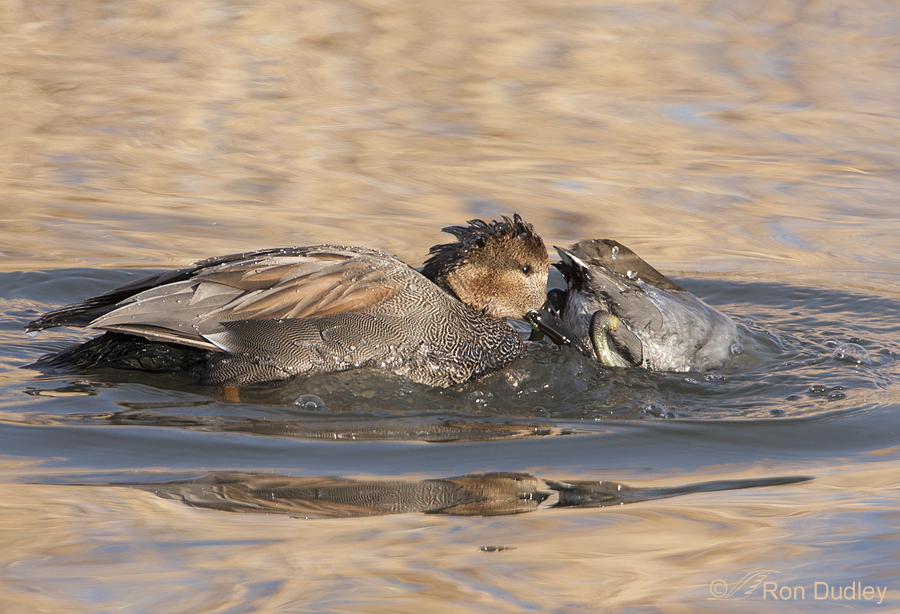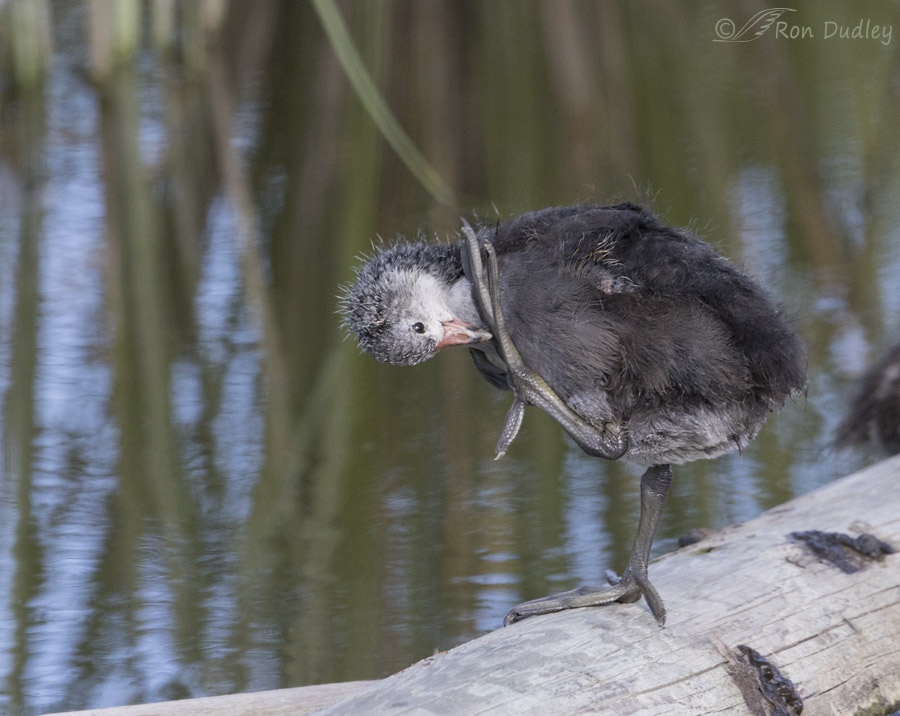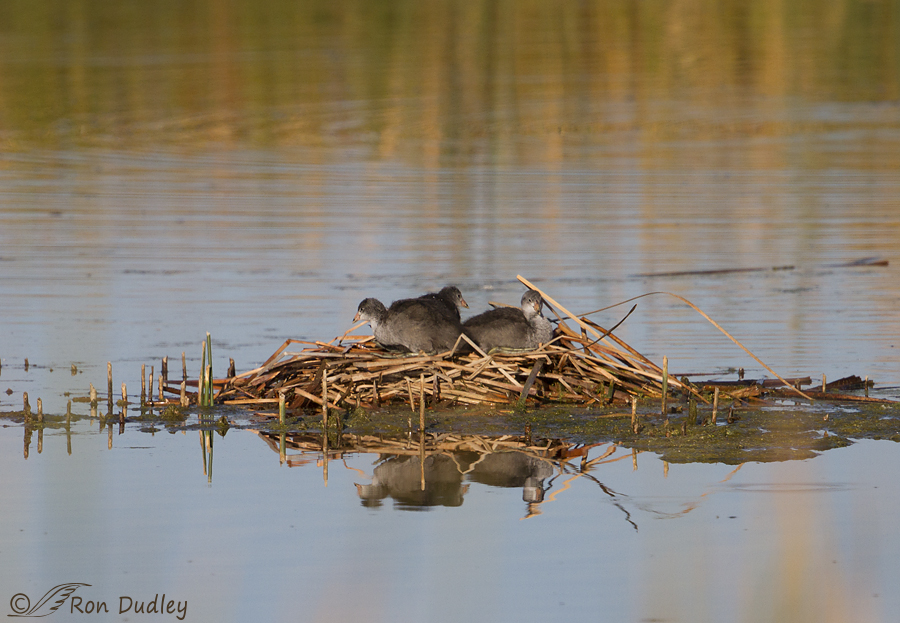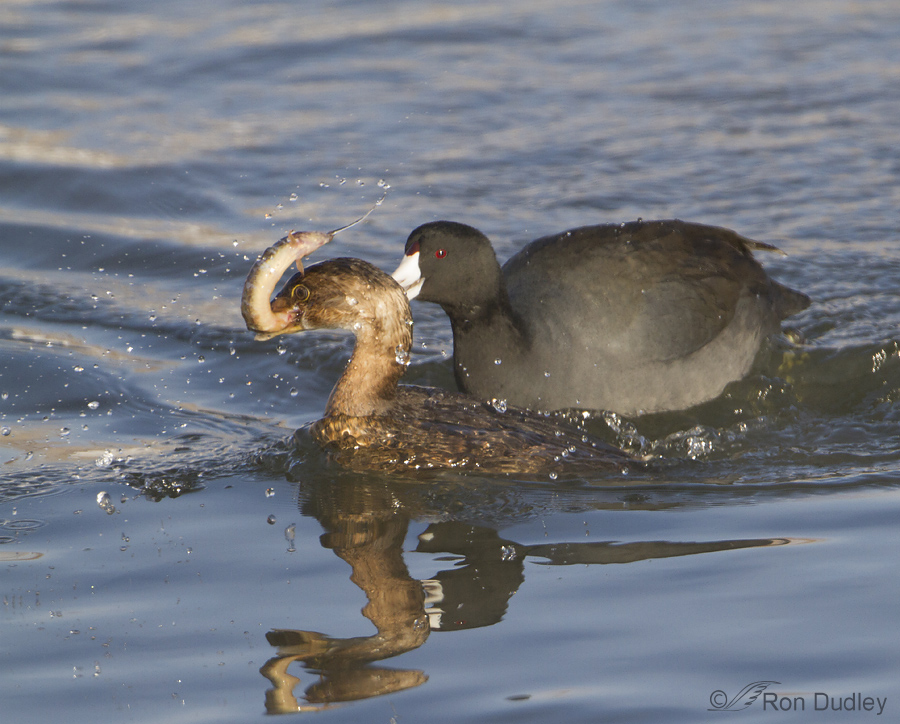Category: American Coots
Have You Seen Birds Nesting This Late In The Season? I Just Did…
A Coot In Pursuit Of A Grebe’s Fish
Gadwall Stealing Food From A Coot

Gadwalls are well-known for stealing food (kleptoparasitism) from American Coots . They eat the same kinds of food (submerged aquatic vegetation), Gadwalls are almost a third bigger than coots and the two species often feed together in mixed flocks so being the bullies on the block, Gadwalls can’t resist taking advantage of the situation.
Coot Running Through Walls Of Water
Coots are quarrelsome, belligerent and cantankerous, especially the males in springtime before the females lay their eggs. Sometimes weaker combatants are killed.
Coots Don’t Like Redheads
Last spring I witnessed quite the little drama between an American Coot and a mated pair of Redheads. I’m going to be a little anthropomorphic here with my narrative (and even my title) – sorry, just can’t resist. The Redheads seemed to be minding their own business but this coot took exception when they came too close to its nest. Here the coot is apparently looking away from the ducks but the Redheads seems to know that something’s potentially up. And it was. I’m always amazed at how fast the reactions of birds are. The Redhead almost seemed to know the attack was in progress before it actually was. You’ll notice that the coot is no closer to him in this second shot than it was in the previous one. The Redhead seems to be trying to use some of the reeds to avoid the approaching coot. The attack continues… and continues… until both birds sense that it’s over and begin to settle back down into the water. The male Redhead reacts with what seems like a celebratory wing-flap that it survived the attack without any damage… and then swims off contentedly with his lady. But the coot isn’t taking any chances and lays low in the water while facing the retreating ducks with a threat pose. I was pleased to get this sequence without clipping any birds and keeping multiple subjects sharp in the frame – not easy to do…
Mean-fighting Coots
American Coots are, without question, the most aquatic, common and widely distributed rail species in North America. Clumsy and awkward fliers, they require long running take-offs to become airborne but they are skilled swimmers – largely due to their lobately webbed toes. And oh, are they ever ornery! But first, allow me to make a few excuses… These images of fighting coots were taken several years ago when I was relatively new to photography. My settings weren’t particularly appropriate so I’m not including them here. And most of these photos were shot in JPEG rather than RAW, so my processing options were extremely limited when I tried to adjust exposure, so the frustratingly white bill is pretty bright in a few of these images. This is one of the aggressive postures used by males to challenge other males. Whenever I see this I know that all hell is about to break loose and I’d better be ready. In my experience, coots have two primary fighting strategies. One is for each bird to lie on their backs in the water while propped up by their wings and tails and strike out at each other with their feet and claws. In this fighting position, their defense is to try to grasp the opposing birds feet. Here we get a good look at those unusual lobed toes. If they become locked together they then fight with their bills. The second fighting strategy uses bills and wings as weapons. If one bird gains the advantage it often tries to force its opponent underwater. The losing bird…
Have You Seen Birds Nesting This Late In The Season? I Just Did…
A Coot In Pursuit Of A Grebe’s Fish
Gadwall Stealing Food From A Coot

Gadwalls are well-known for stealing food (kleptoparasitism) from American Coots . They eat the same kinds of food (submerged aquatic vegetation), Gadwalls are almost a third bigger than coots and the two species often feed together in mixed flocks so being the bullies on the block, Gadwalls can’t resist taking advantage of the situation.
Coot Running Through Walls Of Water
Coots are quarrelsome, belligerent and cantankerous, especially the males in springtime before the females lay their eggs. Sometimes weaker combatants are killed.
Coots Don’t Like Redheads
Last spring I witnessed quite the little drama between an American Coot and a mated pair of Redheads. I’m going to be a little anthropomorphic here with my narrative (and even my title) – sorry, just can’t resist. The Redheads seemed to be minding their own business but this coot took exception when they came too close to its nest. Here the coot is apparently looking away from the ducks but the Redheads seems to know that something’s potentially up. And it was. I’m always amazed at how fast the reactions of birds are. The Redhead almost seemed to know the attack was in progress before it actually was. You’ll notice that the coot is no closer to him in this second shot than it was in the previous one. The Redhead seems to be trying to use some of the reeds to avoid the approaching coot. The attack continues… and continues… until both birds sense that it’s over and begin to settle back down into the water. The male Redhead reacts with what seems like a celebratory wing-flap that it survived the attack without any damage… and then swims off contentedly with his lady. But the coot isn’t taking any chances and lays low in the water while facing the retreating ducks with a threat pose. I was pleased to get this sequence without clipping any birds and keeping multiple subjects sharp in the frame – not easy to do…
Mean-fighting Coots
American Coots are, without question, the most aquatic, common and widely distributed rail species in North America. Clumsy and awkward fliers, they require long running take-offs to become airborne but they are skilled swimmers – largely due to their lobately webbed toes. And oh, are they ever ornery! But first, allow me to make a few excuses… These images of fighting coots were taken several years ago when I was relatively new to photography. My settings weren’t particularly appropriate so I’m not including them here. And most of these photos were shot in JPEG rather than RAW, so my processing options were extremely limited when I tried to adjust exposure, so the frustratingly white bill is pretty bright in a few of these images. This is one of the aggressive postures used by males to challenge other males. Whenever I see this I know that all hell is about to break loose and I’d better be ready. In my experience, coots have two primary fighting strategies. One is for each bird to lie on their backs in the water while propped up by their wings and tails and strike out at each other with their feet and claws. In this fighting position, their defense is to try to grasp the opposing birds feet. Here we get a good look at those unusual lobed toes. If they become locked together they then fight with their bills. The second fighting strategy uses bills and wings as weapons. If one bird gains the advantage it often tries to force its opponent underwater. The losing bird…




